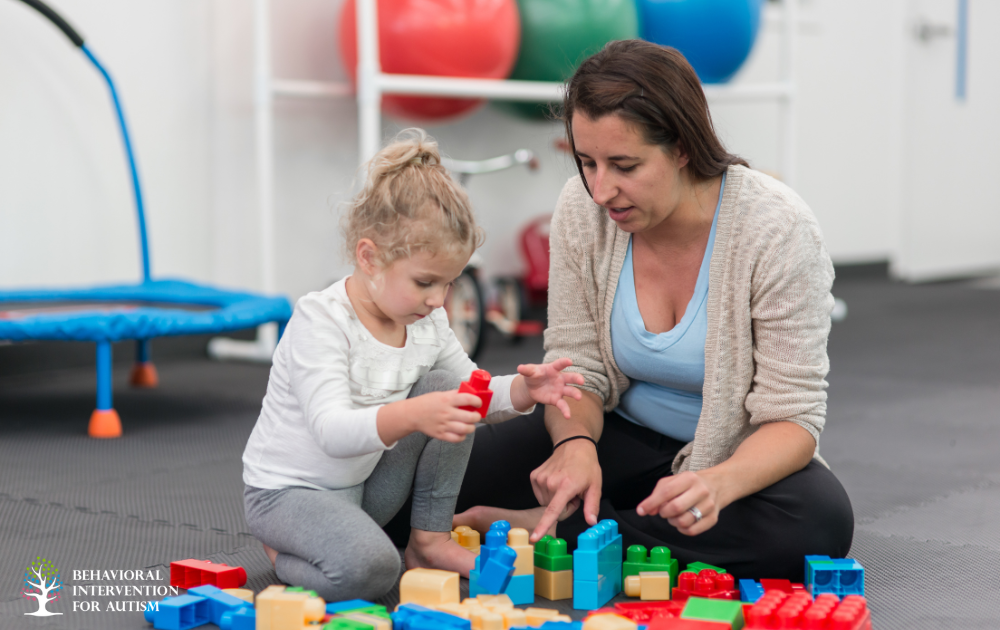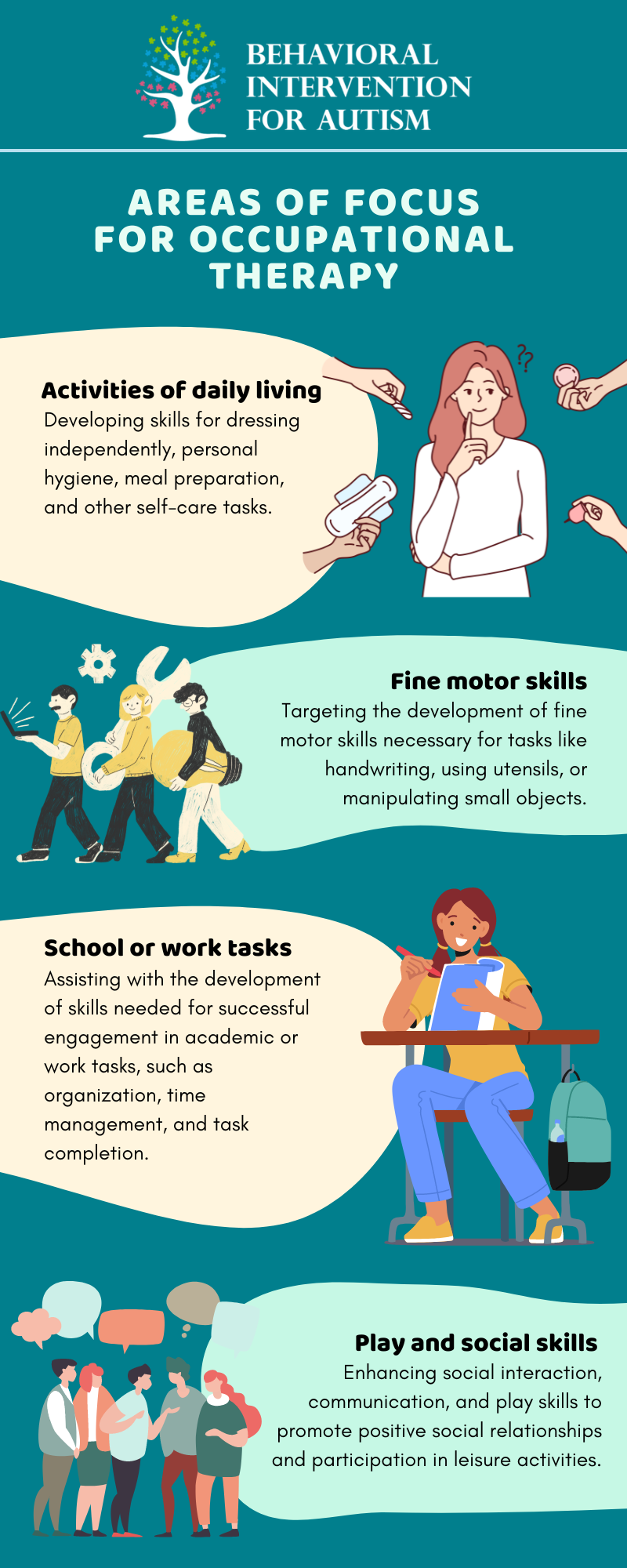
Table of Contents
Approximately one in 36 children in the United States are diagnosed with autism. While signs of autism can be recognized as early as age two, it is typically detected after age five. Early diagnosis and intervention are crucial in improving outcomes for individuals with autism.
During the diagnosis process, healthcare professionals assess various aspects of a child’s development, including motor skills. Impairments in motor skills may manifest as difficulties with coordination, fine motor control, or sensory processing. Identifying these challenges early on allows for targeted intervention and support to enhance motor skill development.
This is where occupational therapy comes in. Let’s have a look at how it can actually help autistic individuals improve their overall quality of life.
Role of Occupational Therapy
Occupational therapy plays a vital role in supporting individuals with ASD and their families. While occupational therapists often work with children who have physical challenges resulting from disorders like cerebral palsy or traumatic brain injury, they also specialize in addressing the specific needs of individuals with autism.
Children on the autism spectrum may not have major physical disabilities, but many experience difficulties with sensory processing, fine motor skills, and social skills.
Occupational therapists are trained to assess skill levels in various developmental areas, identify barriers to independence, and work collaboratively with individuals on the autism spectrum to address motor skills, sensory processing, emotional regulation, cognitive skills, and interactions with caregivers and others.
With a focus on enhancing quality of life and promoting independence, occupational therapists create individualized treatment plans tailored to the unique needs of each individual with ASD.
These plans involve a combination of strategies and techniques to optimize motor skill development, sensory integration, and social interaction.
Occupational Therapy Approaches
Occupational therapists use various approaches to address the unique needs of individuals with ASD. In this section, we’ll explore three common occupational therapy approaches that are often employed. These are as follows:
Sensory Integration Therapy
Sensory integration therapy, which is a form of occupational therapy, has gained recognition for its effectiveness in working with individuals with ASD. This therapy focuses on addressing sensory processing issues that individuals with ASD may experience.
Since 2013, sensory issues have been included in the criteria for autism spectrum disorder.
Sensory integration therapy involves using techniques such as swinging, brushing, jumping, and exposure to selected sounds to help individuals with sensory processing challenges. By providing sensory input in a controlled and therapeutic manner, this therapy aims to help individuals better process and respond to sensory information in their environment.
The goal is to improve sensory regulation, attention, and overall functioning.
Social Skills Training
Social skills training is another important aspect of occupational therapy for individuals with ASD. Many individuals with ASD struggle with social interactions, such as understanding nonverbal cues, initiating conversations, and maintaining appropriate social boundaries.
Occupational therapists work on developing these social skills to improve individuals’ social interactions and enhance their overall quality of life.
Through various techniques and activities, occupational therapists help individuals with ASD learn and practice social skills in a structured and supportive environment. This may include role-playing, social stories, and group activities.
The goal is to improve communication, social engagement, and the ability to navigate social situations successfully.
Fine Motor Skills Development
Fine motor skills refer to the coordination and control of small muscles in the hands and fingers. Many individuals with ASD may face challenges in this area, impacting their ability to perform tasks such as writing, using utensils, and manipulating small objects.
Occupational therapy focuses on developing and improving these fine motor skills to enhance independence and functionality.
Occupational therapists use a variety of activities and exercises to target specific fine motor skills. These may include puzzles, playdough, threading beads, and using tweezers. By engaging in these activities, individuals with ASD can enhance their hand-eye coordination, dexterity, and precision in their fine motor movements.
Goals of Occupational Therapy
Occupational therapy for autism aims to improve the quality of life for individuals with ASD and promote their independence. By addressing the unique needs and challenges associated with ASD, occupational therapists work towards enhancing various aspects of an individual’s life.
Here are its primary goals:
Enhance Quality of Life
Enhancing the quality of life is a primary goal of occupational therapy for individuals with ASD.
Occupational therapists (OTs) strive to help individuals access their natural environments with greater ease, allowing them to engage in daily activities and participate in meaningful experiences.
By focusing on the individual’s strengths and abilities, occupational therapy aims to improve overall well-being, satisfaction, and enjoyment in life.
Through therapeutic interventions, individuals with ASD can develop skills necessary for self-care, social interaction, and participation in various activities. Occupational therapy helps individuals build confidence, self-esteem, and a sense of accomplishment, leading to a better quality of life.
Promote Independence
Promoting independence is another crucial goal of occupational therapy for individuals with ASD. Occupational therapists work closely with individuals to help them develop the skills needed to navigate their environment and perform daily tasks independently. This includes focusing on areas such as self-care tasks, fine motor skills, play skills, social skills, and sensory processing needs.
By targeting these areas, occupational therapy equips individuals with the tools necessary to function more independently in their everyday lives. This may involve teaching strategies for self-regulation, promoting effective communication and social interaction, improving motor coordination, and developing problem-solving skills.
The ultimate aim is to empower individuals with ASD to become more self-reliant and capable of engaging in activities that are important to them.
Occupational therapy goals for individuals with ASD are individualized and tailored to meet the specific needs and abilities of each person. By working collaboratively with individuals, families, and caregivers, occupational therapists strive to create treatment plans that promote optimal outcomes and support long-term success.
Individualized Treatment Plans
The key to a successful occupational therapy session lies in developing individualized treatment plans. These plans are tailored to the specific needs of each individual, taking into account their unique challenges and strengths.
There are two important components involved in individualized treatment plans. Let’s look at each of them.
Assessment and Evaluation
Before beginning occupational therapy, an assessment and evaluation process is conducted to gather information about the individual’s abilities, challenges, and areas of need. Occupational therapists use established tests and evaluations to determine the support needs of individuals with ASD.
This comprehensive assessment helps identify barriers to independence and provides valuable insights into the individual’s motor skills, sensory processing, emotional regulation, cognitive abilities, and interactions with caregivers and others.
During the assessment, occupational therapists evaluate various developmental areas, including but not limited to:
- Motor skills – Assessing both gross motor skills (such as coordination and balance) and fine motor skills (such as hand-eye coordination and dexterity).
- Sensory processing – Identifying how the individual responds to sensory stimuli and addressing any sensory processing differences.
- Emotional regulation – Understanding how the individual manages and expresses emotions.
- Cognitive skills – Assessing cognitive abilities in areas such as attention, problem-solving, and memory.
Based on the assessment results, the occupational therapist gains a comprehensive understanding of the individual’s strengths and areas that require support. This forms the foundation for developing a personalized treatment plan.
Personalized Goal Setting
After the assessment, the occupational therapist works closely with the individual and their caregivers to set personalized goals. These goals are specific to the individual’s needs and focus on enhancing their independence and overall quality of life.
The goals set in occupational therapy for individuals with ASD can vary widely depending on the individual’s age, abilities, and areas of challenge.
Some common areas of focus include:
These goals are regularly monitored, reviewed, and modified as the individual progresses in their occupational therapy journey. The personalized nature of the treatment plan ensures that the therapy is targeted and effective in addressing the unique needs of individuals with ASD.
Occupational Therapy Techniques
To achieve successful results, occupational therapists normally use a range of techniques and interventions to address the unique needs of each individual.
Here are three common occupational therapy techniques used in the treatment of ASD:
Play Therapy
Play therapy is a therapeutic technique that uses play as a means of communication and interaction. It allows children with ASD to engage in meaningful activities while targeting specific goals. Occupational therapists often incorporate play therapy into their sessions to promote social skills, sensory integration, and motor development.
Through play, therapists can create a safe and supportive environment where children can explore and experiment with different play materials, toys, and activities. This approach helps children with ASD develop social skills, improve communication, enhance problem-solving abilities, and regulate sensory input.
Handwriting Therapy
Handwriting therapy focuses on improving fine motor skills, coordination, and handwriting abilities in individuals with ASD. Occupational therapists use various techniques and exercises to help children develop the necessary hand strength, dexterity, and control required for handwriting.
These therapy sessions may include activities such as tracing, letter formation exercises, and strengthening exercises for the hand muscles. Additionally, therapists may use specialized tools like pencil grips or adaptive writing utensils to assist children with handwriting difficulties.
Behavioral Therapy
Behavioral therapy is a widely used approach in occupational therapy for individuals with ASD. This technique focuses on addressing challenging behaviors and promoting positive changes in daily routines and activities.
Occupational therapists work closely with individuals and their families to identify triggers, develop strategies, and reinforce desired behaviors.
Behavioral therapy may involve creating structured environments, implementing visual schedules or social stories, and utilizing techniques such as positive reinforcement and behavior modification. The goal is to support individuals with ASD in managing their behaviors, improving social interactions, and enhancing their overall functioning.
Occupational therapists who specialize in working with individuals with ASD may utilize one or more of these techniques in their therapy sessions. The choice of technique depends on the individual’s specific needs, goals, and interests.
By tailoring the therapy approach to the unique requirements of each individual, occupational therapists can help individuals with ASD gain greater independence, improve their motor skills, and participate more fully in their daily activities.
Collaboration and Support
Collaboration and support are also essential components of occupational therapy for individuals with Autism Spectrum Disorder (ASD). Occupational therapists work closely with various stakeholders, including schools, caregivers, and other professionals, to provide comprehensive support and optimize the outcomes of therapy.
School-Based Therapy
Occupational therapists may provide therapy services to children with ASD in school settings. This can involve therapy sessions conducted within the classroom or in one-on-one settings.
In school-based therapy, occupational therapists collaborate with teachers and other school staff to address the specific needs of the child.
Therapists may also utilize sensory rooms within schools, equipped with specialized equipment such as swings and trampolines, to facilitate therapy sessions. These sensory rooms create a supportive environment where children with ASD can engage in activities that promote sensory integration, fine motor skills development, and social interactions.
In-Home Interventions
In addition to school-based therapy, occupational therapists may also work with very young children with ASD in their homes. Home-based interventions allow therapists to provide individualized therapy tailored to the specific needs of the child within their familiar environment.
Working directly with the child in their home allows therapists to address daily living skills, sensory integration, and social skills development within the context of the child’s daily routines.
Furthermore, therapists can train parents and caregivers to continue therapeutic interventions between therapy sessions, ensuring consistency and generalization of skills.
Involvement of Caregivers
The involvement of caregivers is crucial in occupational therapy for individuals with ASD. Occupational therapists recognize the importance of empowering caregivers with the knowledge and skills necessary to support the child’s development and progress outside of therapy sessions.
Therapists provide guidance and training to parents and caregivers, equipping them with strategies and techniques to facilitate the child’s motor skills, sensory integration, and social interactions in everyday activities.
By involving caregivers in the therapy process, occupational therapists foster a collaborative approach that maximizes the child’s progress and functional outcomes.
Collaboration and support play a vital role in the success of occupational therapy for individuals with ASD. Through collaboration with schools, in-home interventions, and the involvement of caregivers, occupational therapists create a comprehensive support system that promotes the child’s independence, functional abilities, and overall quality of life.
Reach out today to see how our high-quality ABA therapy in Florida can help you. Get in touch to learn more and start making a positive impact on your child’s development.
Sources:
https://www.usa.edu/blog/occupational-therapy-for-autism
https://www.autism.org.uk/advice-and-guidance/professional-practice/occupation-therapy
https://www.lifespan.org/lifespan-living/how-occupational-therapy-can-help-children-autism
https://www.verywellhealth.com/occupational-therapy-for-autism-4783594
https://abilityactionaustralia.com.au/the-role-of-occupational-therapy-in-autism
- 9 Common Obsessions of Children With Autism You Should Know - February 25, 2025
- What is Neurodiversity? A Guide to Embracing Differences - February 25, 2025
- Understanding Hyperfocus in Autism: What It Means and Why It Happens - February 25, 2025






